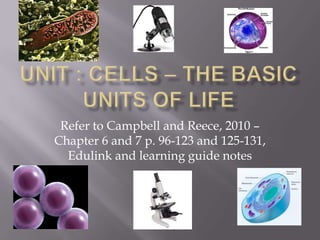
Unit 2 cells
- 1. Refer to Campbell and Reece, 2010 – Chapter 6 and 7 p. 96-123 and 125-131, Edulink and learning guide notes
- 2. The study of cells and micro organisms has changed over time with the change in technology. These were studied in the beginning with hand lenses, single lens microscope, light microscope Today we have electron microscopes. Two types of electron microscopes are used today: SEM – Scanning electron microscope and TEM – Transmission electron microscope.
- 3. Developed a microscope with one lens. Discovered - bacteria - blood cells - spermatozoa - protozoa
- 4. Uses the concept cell for the first time. He used it when he looked at the microscopic structure of cork cells.
- 5. Describes the nucleus of a cell
- 6. Developed the cell theory: - Plants and animals are made of groups of cells. - The cell is the basic unit of living organisms
- 7. Expanded the cell theory: He said that new cells formed by the division of existing cells
- 8. Expanded the cell theory more: He said that all cells can be traced to their origin
- 9. All living organisms are made out of cells New cells are formed by the division of existing cells The cell houses genes, which are the blueprint for growth, functioning and development of cells The cell is the functional unit of life because all chemical reactions of life take place inside the cell
- 10. A cell is the basic unit of structure and function in organisms. Cells differ in size, shape and in function. A cell consist of smaller structures called organelles.
- 11. Prokaryotic or Eukaryotic cells. Only organisms of the domains Bacteria and Archaea consist of prokaryotic cells – cells without a membrane bound nucleus. Protists, fungi, animals and plants all consist of eukaryotic cells – cell with a membrane bound nucleus.
- 16. PLANT CELL ANIMAL CELL
- 17. Chapter 6 p. 98 – 131
- 18. Porous Varies in thickness Consist of pectin (elasticity), cellulose fibrils held together with non-cellulose substances (hardens the cell when mature) and lignin (adds strength to cell especially in woody plants) Cell wall is permeable and protects the inside of the cell. Middle lamella (layer of adhesive substances) – holds the cells together Plasmodesmata (pores) that connects the cytoplasm of the connecting cells – selectively permeable
- 20. Consist of 2 phospholipid layers and proteins in between. The phospholipid layers are part hydrophillic and part hydrophobic
- 21. +/- 5µm, largest organelle in cell. Enclosed by a nucleomembrane with nuclear pores. Function: Protection and add to selective permeability. Filled with nucleoplasma, a nucleolus and chromatin. Function of chromatin: carries genetic material in the form of chromosomes. Function of nucleolus: Produce r- RNA
- 22. Consist of 2 membranes: Outer – and a highly convoluted inner membrane- These folds are called cristae – they increase the surface area. Filled with matrix called stroma that contains DNA and ribosomes. Function: Produce energy in the form of ATP by means of cellular respiration
- 23. Enclosed by a double membrane Filled with stroma and thylakoids filled with chlorophyll arranged in groups called grana. Ribosomes and starch grains in stroma. Function: Photosynthesis
- 24. Membranous sac Filled with cell sap. Causes turgor pressure in the vacuole. Function: Stores various substances, including waste. Helps with osmotic potential of cell.
- 25. Endoplasmic Reticulum – Transport system in cell Ribosomes – Protein synthesis Golgi-apparatus – Make lysosomes and acts as transport system. Lysosomes – Intracellular digestion. Plastids e.g.– Leucoplasts – Stores starch - Chromoplast – gives colour to flowers and fruit. * Centrioli – Mitosis in animal cells
- 26. The cell membrane has the ability to regulate transport molecules across its structure. This function is essential to the cell’s existence. The fluid mosaic model helps to explain how membranes regulate the cell’s molecular traffic.
- 27. Hydrocarbons, carbon dioxide and oxygen – non-polar So they can dissolve in the lipid bilayer of the membrane. They can cross the membrane without the aid of membrane proteins. Polar molecules like, water and glucose move slowly across the membrane and need the aid of proteins to get across the membrane.
- 28. Hydrophyllic substances can avoid contact with the hydrophobic lipid bilayer by passing through transport proteins that span the membrane. Channel proteins – tunnel for polar molecules to pass through membrane Aquaporins – channel proteins for the transport of water
- 29. Carrier protein: Hold onto solutes that want to move across the membrane and changes shape as it moves through the membrane. Each carrier protein is specific to what it transports.
- 30. The microscope is an instrument designed to observe objects too small to be seen with the naked eye. The human eye cannot distinguish objects much smaller than 0.1mm. The microscope act as an extension of the eye, allowing one to see smaller objects.
- 32. STUDY HOW TO TAKE CARE OF THE MICROSCOPE AND HOW TO MAKE A MICROSCOPE SLIDE.
